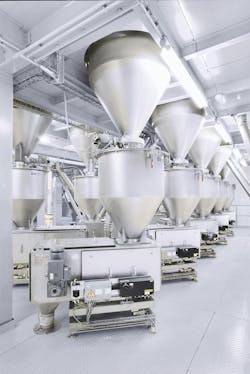Feeding equipment for dry bulk materials, from powders and pellets to flakes and granules, comes in many shapes and forms. Gravimetric feeding solutions range from screw feeders to vibratory feeders to weighbelt feeders. Each feeder type has benefits and limitations, and in many cases, more than one type will solve the problem and provide the desired result.
The screw feeder is light industry’s primary gravimetric feeder due to its versatility to accommodate a wide range of dry bulk materials, its flow rate customizability, and its ability to meet upstream and downstream process needs. Lighter duty vibratory feeders are great where material degradation is the primary concern, for example, with chocolate chips in snack foods. Vibratory feeders are great for high temperature materials in heavier duty applications, such as the power or mineral industries. Weighbelt feeders are the preferred solution for larger bulk materials or applications with higher feed rates.
This article will cover both light-duty and heavy-duty weighbelts as well as belt scales for weighing material on belt conveyors designed to CEMA standards.
Light-duty weighbelts
Light-duty weighbelt feeders are a good choice for any bulk material that is free flowing and friable or easily damaged. They are also a good choice for materials with large particle sizes up to a maximum diameter of 1.5 inches and other materials that would cause issues for a screw feeder. These weighbelts are typically available in 12- or 24-inch widths, with volumetric flow rates up to 1,700 ft3/hr. Weighbelts are typically flood fed, inventorying material at the inlet and pulling a given height of material away on the belt by passing the material under a shear gate. Sticky materials are not recommended, as buildup on the belt can lead to weighing accuracy challenges, even when using belt cleaners.
Weighbelts have relatively small headroom requirements, making them an ideal choice when a screw feeder or vibratory feeder is too tall or large.
Weighbelt feeders are designed for multiple operating scenarios, depending on process requirements:
- The feeder can run continuously, automatically adjusting its speed to discharge a given weight of material per unit of time. Feed rates are normally customizable and/or field adjustable to accommodate a range of bulk materials, provided that the feeder is sized appropriately.
- The feeder can totalize the amount of material fed into a process and can be reset at customizable intervals.
- The feeder can run in batch mode, discharging a given amount of material in a specific time.
Downstream of the inlet and shear gate is the weigh deck, where a strain gage or load cell measures the weight of material. That signal is sent to a controller, where it is converted into a weight for gravimetric analysis and control.
Accuracies vary depending on the type of material and the required feed rate. Typical accuracies range between ±0.5% and ±1% to 2σ. Under the right circumstances, accuracies of ± 0.25% are possible. While common materials have known bulk material properties allowing for easy equipment configuration, it is always a good idea to run pilot-scale tests in an equipment manufacturer’s lab, if available, to select the options that will lead to the best accuracies.
Weighbelts typically have a cantilevered-shaft design, making belt removal from the non-drive side of the feeder relatively quick. Taking slack out of the belt varies by manufacturer, with some using tensioners and others using a cam-type design.
Open-frame designs are available for sanitary and washdown applications in the food industry. These weighbelts typically have tool-less belt removal and a sanitary flex connector on the inlet port for quick cleaning and maintenance. The direct-drive system is located on the tail of the feeder to mitigate product contamination. The types of operation and accuracies are normally the same as with standard “closed” weighbelts. Given the open design, maximum volumetric flow rates are typically higher than the standard design, with rates approaching 2,700 ft3/hr.
Heavy-duty weighbelts
Heavy-duty weighbelt feeders include heavier-duty components; feed at higher rates, for example, 500+ tph of frac sand or gypsum; and handle larger particle sizes, for example, lumpy materials up to 4 inches in diameter. Belt widths range from 24 inches to 72 inches, and lengths are custom, based on the specific process and layout requirements. Depending on the material to be weighed, the belts can be flat or may have corrugated flanges to prevent small particles or powders from rolling off the sides. Like the lighter-duty version, these weighbelts typically include a shear gate to profile the material on the belt for more consistent weighing and can run in continuous, totalizing, or batch mode.
The weight of material on the belt is measured downstream of the inlet and shear gate with a set of load cells under an idler. Accuracies of ±0.5% to 2σ can be achieved, with rate turndowns of 10 to 1. With less rate variability, better accuracy is possible.
Most heavy-duty weighbelts have removeable members with a cantilevered design such that an endless, vulcanized belt can be installed from the non-drive side. Tension on the belt is usually achieved through a gravity-type tensioner, which stabilizes sag between idlers and provides reliable drive traction.
Belt scales
Belt scales are an easy way to continuously measure rates or totalize amounts over time and for process and transfer systems with high rates or where existing belt conveyors are used, for example when transferring sand, gypsum, gravel, etc. Belt scales can typically handle 15,000 tph and can be installed on belts meeting CEMA standards, from 18 inches to 60 inches wide. Existing belts can be retrofit as long as they meet CEMA standards. While belt-scale designs can vary, the easiest versions to implement are those that replace one idler from a belt conveyor with the scale assembly (including load cells). Areas to consider include upstream routing and material addition, as those can affect accuracy.
Belt scales can be used in scenarios where they are running continuously to provide real-time rates of material traveling on the belt or while totalizing, where the scale sums material traveling on the belt over time and can be reset as required by the operator or process.
Typically, an accuracy of ±1% is achievable over a 3-to-1 rate turndown when installed on one idler. Using this scale system on two consecutive idlers can increase that accuracy to ±0.5%. As with weighbelts, significant rate fluctuation and upstream additions to belts near the scale will affect accuracy. Installing these scales on belts that are inclined or declined can also lead to accuracy issues.
Belt scales have relatively little required maintenance, but it is important to calibrate the load cells consistently to ensure long-term process accuracy. Many belt scales are supplied with static weights to allow offline calibration. Online calibration is possible but can be difficult, depending on process design.
William Del’Ve ([email protected], 816-518-0463) is a sales executive with Schenck Process Food and Performance Materials, a company of Coperion, who has over 20 years of experience in bulk material handling and processing in the performance materials, food, and power generation industries.
Schenck Process FPM
www.schenckprocessfpm.com






